|
INTRODUCTION
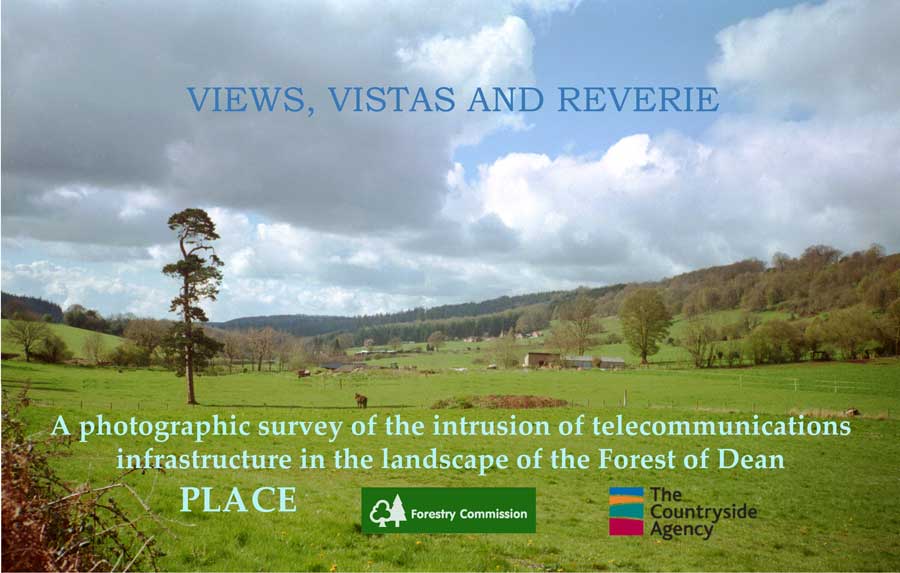
Most people are familiar
with the concept of endangered species. We believe there are also endangered
experiences.
An empty sky, for instance, or the dark of the night sky unaffected by
manufactured light,
both of which would have been common experiences in the relatively recent
past,
have all but disappeared.
Spatial freedom in landscapes clear of human structures is ever more rare in
the British Isles.
Absolute aloneness is difficult to find. A sense of the frailty and
inconsequence of human life when immersed in the vastness of the elements,
gives a much needed and powerful change of perspective. We believe that
humanity is diminished by the
ongoing loss of such experiences. Many of these losses are unnecessary.
This survey is based upon the area of the Forest of
Dean District Council which is approximately 200 square miles
(52,600
hectares) and has a population of approximately 80,000. The survey took
place from June 2004 to June 2005.
Note on the electronic
manipulation of imagery:
About 15% of the images have had the definition
of the mast enhanced. This is to try to match the image to my actual
experience of the mast in landscape. Enhancement has been used exclusively
for distant panoramic shots where the power of human vision is much superior
to technology; it has not been used for dramatic effect.
Base Station is the term given to a mobile phone
transmitter / receiver mast and its ancillary ground-based equipment cabins.
Abbreviations in the text: ant = antennae; galv.= galvanised; dish = dish
antennae
Where no site number is visible or decipherable at the site, the text reads:
site No-;
Andrew Darke undertook the survey which was funded by PLACE and The
Countryside Agency, with support from the Forestry Commission.
Many thanks for help to Jonathan Adamson, Lin
Thomas, Dr. Richard Cowell, Pam Day.
© PLACE September 2005
PLACE
Field House
Yorkley Wood
Nr. Lydney
Gloucestershire
GL15 4TU
UK
Tel. +44(0)1594 562646 |
Forestry Commission
340, Bristol Business Park
Coldharbour Lane
Bristol
BS16 1EJ
UK
www.forestry.gov.uk
Tel. +44(0)1179 9066000 |
The Countryside Agency
John Dower House
Crescent Place
Cheltenham
Gloucestershire
GL50 3RA
UK
www.countryside.gov.uk
Tel. +44(0)1242 521381 |
Base Station at Wyedean School,
Sedbury Grid Ref. 545 939
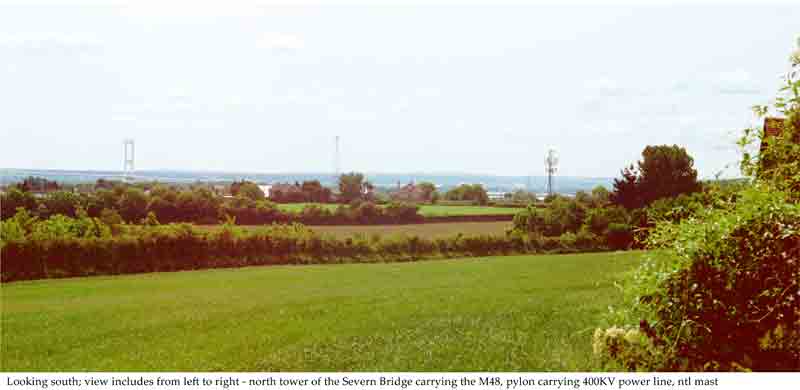
ntl site No. -;
multi-operator site. 30m lattice tower. 3 colinear antennae, 16 sector
antennae, 1 dish ant., other directional ants. Aggressive grey palisade
fencing, grey and brick equipment cabins. No planting.
Comments: Very ugly,
tall intrusive mast with a confusion of antennae, sited in school grounds
and very close to council housing - unlikely that such a siting would be
allowed now. Very intrusive into surrounding rural views.
Urgent Amelioration
Needed: Demolish and relocate away from school and community using low
impact method to blend into the environment.
(see The Crieff Solution.)
Base Station at Wyedean School,
Sedbury Grid Ref. 545 939
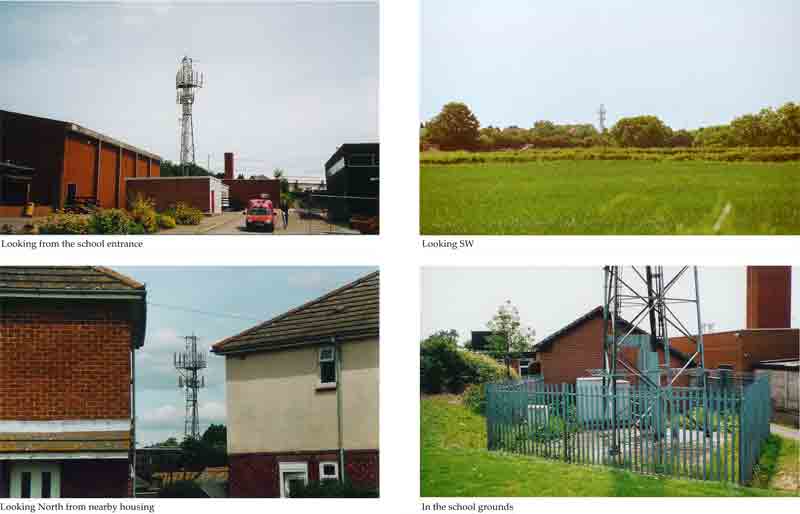
The
purpose of this document is to draw attention to an insidious and damaging
process which is eroding the quality and tranquility of rural landscapes in
Britain and worldwide. High places and horizons are particularly under
attack as both mobile telephone base stations and wind turbines are at their
most efficient when placed on high sites. They add to the longer term
intrusions of TV broadcast and military communications installations. High
places are persistently undervalued in a market economy as they are, from a
strictly economic point of view, underused; their value remains un-priced
and apparently un-quantifiable. This value system is clearly inadequate for
dealing with the aesthetic and existential qualities of landscape. Value is expressed in the language of aesthetic and scientific
appreciation and consequent landscape designation eg. “areas of outstanding
natural beauty,” “special landscapes,” “sites of special scientific
interest” but a sterling value remains elusive. Even a relatively small
change or intrusion in these areas can cause a dramatic diminution in their
quality, for instance, of wildness or habitat.
As each
new infrastructure is proposed and then perceived by government to be the
next irresistible economic benefit another degree of intrusion in landscape
by technical structures is sanctioned by a society which has become largely
disconnected from the land. A new reduction of the possibility of
experiences of otherness (wildness, non humanness, etc.) occurs. Yet more
places Gerard Manley Hopkins might have described as “sweet especial scene,
rural scene, a rural scene, sweet especial rural scene”* are engulfed for
economic gain as against the uncalculated and incalculable benefit of a
reverie in rural tranquility…….. or of simply “leaving well alone.”
In the case of wind
generation, to have a planning policy which either by default (or intent!),
results in the severe degradation of fine local landscapes in the name of
global environmentalism seems, at best unimaginative or at worst, a
blundering own goal. For instance wind farm proposals for the Isle of Lewis
and for Whinash in Cumbria which would perform a desecration on these places
seriously degrading some of our most prized landscapes and extending
blighted areas a further 30 or so miles around, owing to the size of the
structures proposed.
Surely coastal areas which
are already heavily industrialized and are close to centres of power demand,
thus reducing the need for transmission lines, should be sites for wind
power generation?
The current pressures for
renewable energy, mobile telephone and internet connection for all, new
roads, new power lines, airport extensions etc. are going to increase rather
than reduce. Our internationally famous landscapes are now in dire need of a
new thoroughgoing system of protection. If anyone is in doubt as to the
importance of landscape to national identity, one need only spend a little
time looking at the amount of landscape imagery used in advertising, or the
mass of references to the land in cultural output.
Recent governments have not
kept pace with the rise in importance of environmental quality to large
numbers of the population. General planning policy has been amended
incrementally without addressing the totality of the real situation or the
impact of new infrastructures, such as the mobile phone system. For instance
the mobile operators have been allowed to continue adding to their
infrastructure without ever giving a reliable estimate of how many base
stations might be needed and what their impact on landscape might be! Why
has this industry been given such an unprecedented carte blanche? Does the
£22.5 billion license fee have any bearing on it?
A new
vision for planning policy is required which is pro-active, strategic and
retrospective (ie. a permission can expire and restoration be required).
In
order to make good the poor governmental response to the rising concern for
environmental quality, PLACE proposes that planning law be amended so that
there is a “presumption against,” as currently in AONBs, the
siting of any new infrastructures outside of urban, suburban areas or
urbanized corridors (new definitions will be required eg. urbanized
corridors - major road/rail corridors.)** The developer, or government,
should be obliged to prove an incontrovertible need for intrusion into land
beyond the latter three categories. Should that need be established in an
Inquiry, then the developer should be required to offer his plans for
mitigation to full scrutiny and debate and subsequent amendment. A new era
of respect for landscape and environment quality would begin, which is of
course, what renewable energy is all about.
*
from “Binsey Poplars” by Gerard Manley Hopkins
** see PLACE’s national street lighting/ mobile
phone system
To
return to horizons and the increasing impact of mobile phone infrastructure
there, horizons tend to be the point at which a gaze comes to rest and as
more and more masts and other structures are placed on or near horizons, the
quality of views and vistas becomes diminished.
A
gaze out over any extensive view will always include a horizon, that
essential meeting point between sky and land or sky and water. Periods of
gazing (a gaze: a long intent look – Longmans Modern English Dictionary) are
usually accompanied by a cessation of the immediate day-to-day practical,
logistical thought processes. In my own experience, these are replaced
during gazing, by a more reflective, lateral and expansive type of thought.
The eye travels over and through space alighting upon and inquiring about,
say, a subtle change in colour of the tree canopy, or some secretive
declivity where a stream has cut down into the flank of a mountain. The
eye-mind begins to speculate on that change of colour – a cooler air perhaps
flows up from the estuary there or, a slightly unwelcome increase in acidity
in the soil... or perhaps a reminder of the colour of a head of hair… a gaze
may turn into a reverie. The eye-mind begins to flicker between internal
experience, memory, new ideas and then back again absorbing the external
scene. The eye wanders up to the horizon… comes to rest there… dips in and
through and along and takes off into beyond.
What is the mind
doing? Exploring, finding, searching perhaps… or reflecting, re-living,
renewing, refreshing perhaps… imagining… understanding, or perhaps lying
fallow, … or just gazing. This long uninterrupted moment is so
important.
My gaze wanders
along the horizon – ouch!
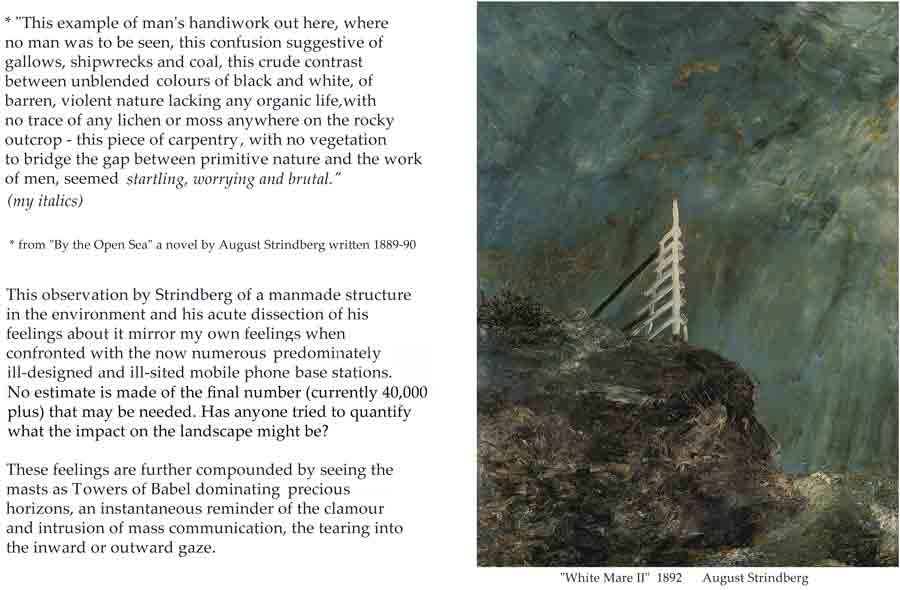
The
development of the mobile telephone industry over the last 10-15 years has
been accompanied by the requirement for technical infrastructure in the form
of base stations consisting of masts, antennae and equipment cabins. The
ever increasing numbers of base stations are now causing significant damage
to views and vistas in rural areas, often compromising roofscapes and
architectural form in urban areas and causing distress to many local people
worried over landscape quality and potential health impacts.
This
survey is a snapshot of the situation here in the Forest of Dean in 2004-5.
Note that PLACE shares current health concerns regarding the new technology,
but the subject of this document is the loss of certain sorts of experience
in landscape as a result of the intrusion of technical infrastructure. The
study of this rural area will be a reference point for comparisons with
future development. It can be extrapolated to cover most rural parts
of the UK. The principles and many of the methods of amelioration
are certainly suitable for semi-rural areas and suburbia. The document
points to practical ways forward for a reduction in the intrusiveness of the
technology through a number of simple, effective measures.
Another
possibility is the re-conceiving of the entire mobile phone network so that
all the infrastructure is sited alongside the road and rail networks. This
proposal by PLACE arises out of a number of observations:
This is where most people are
most of the time – properties of all types and uses are connected by
roads.
All the mobile phone companies
design some of their base stations in or on street lighting type poles
which can be fitted, in visual terms, very successfully into the urban,
suburban, semi-rural design culture (fabric) of roads.
Such base stations are lower
powered than those on lattice towers - ie. more would be needed, but the
increase in numbers would fit in well with the need to shrink cell size in
order to accommodate more phone users.
Roads tend to be in valleys and
therefore lower; thus high places and horizons would be freed from
technical infrastructure.
Mountains, moorlands and remote
wild places where there are few roads would be less intruded upon and
their more dangerous and less humanly transformed quality better
preserved.
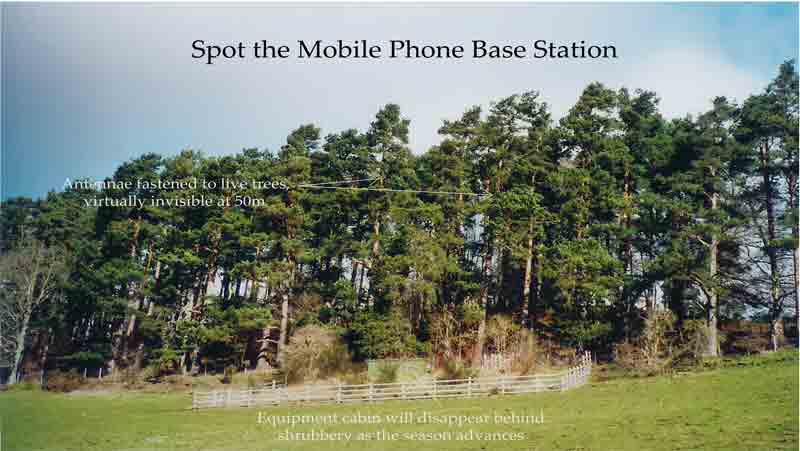
Experience
shows that landowners can have a strong influence on the type of mast built.
They should
insist that the best solution for the landscape is used. This site was built
by Vodafone. (Site No. 4788)
See Base Stations Bullo (wood finish pole), Berry Hill, Harrow Hill, Newent, (street lighting type
base station) |